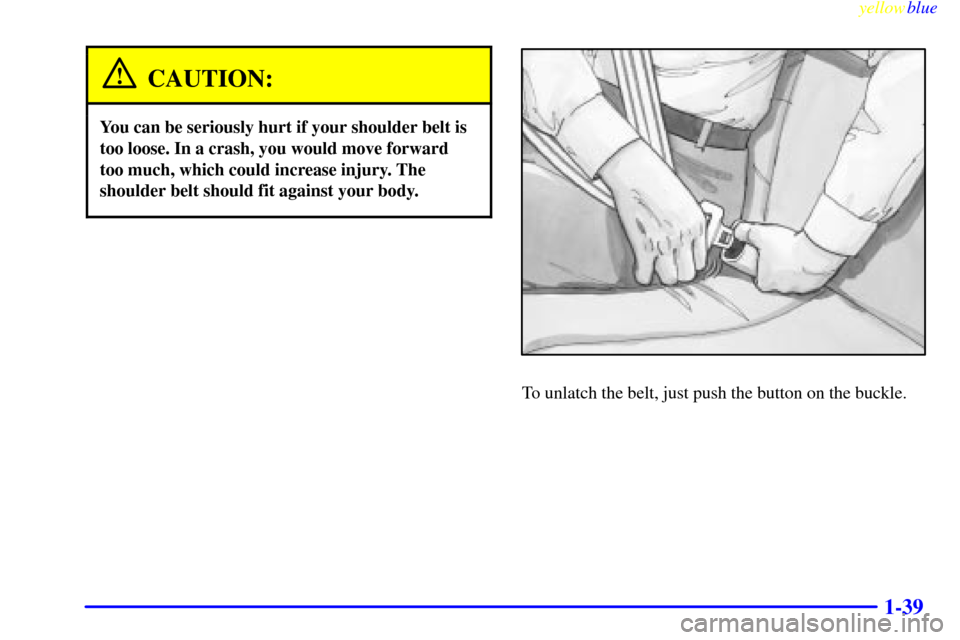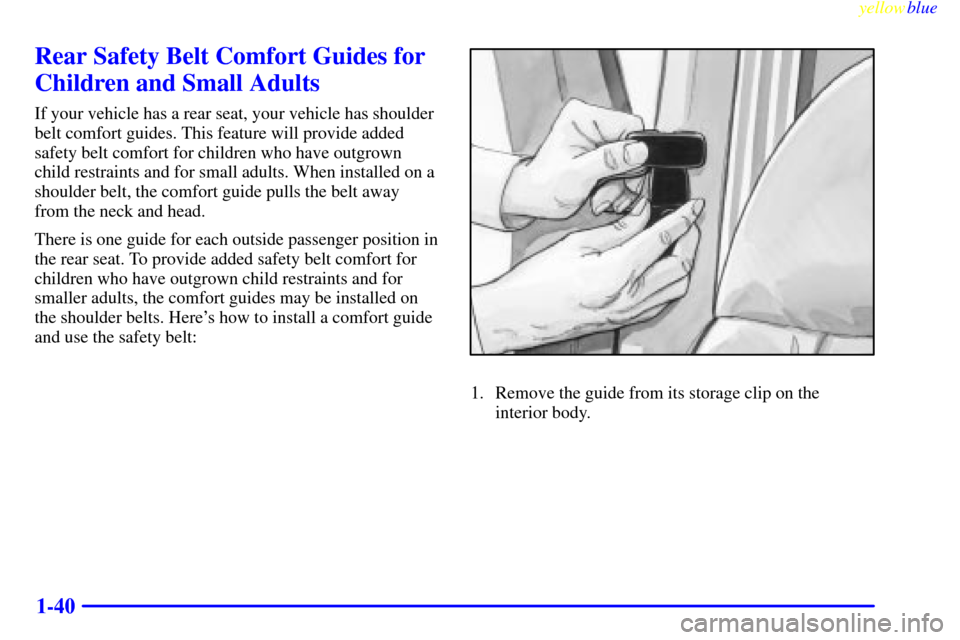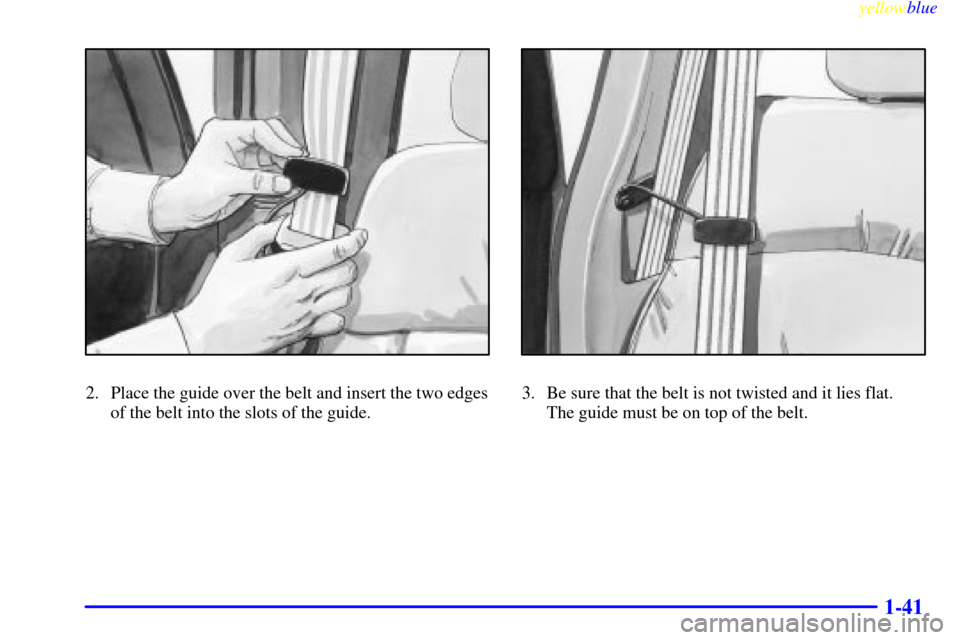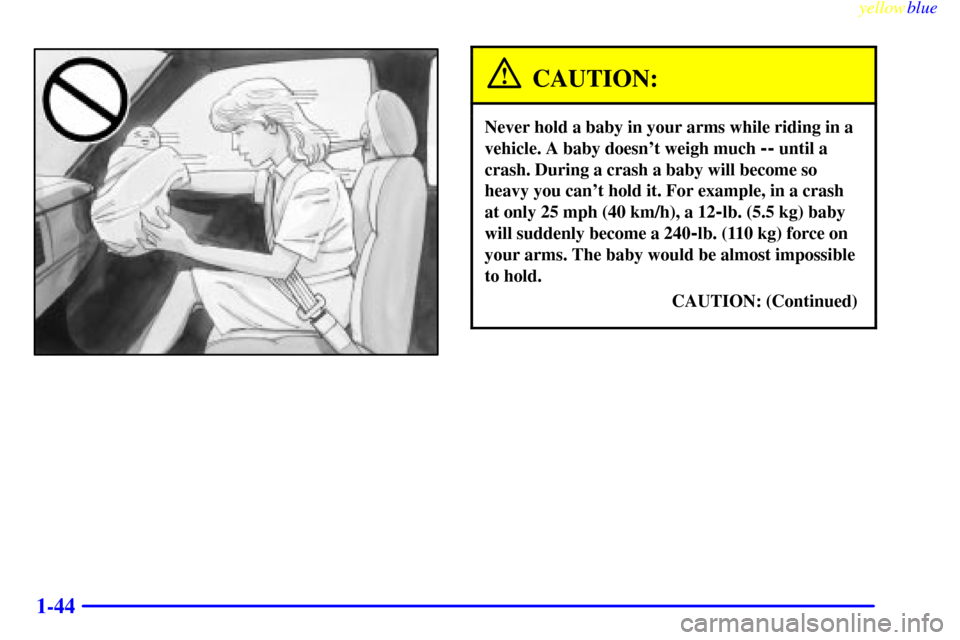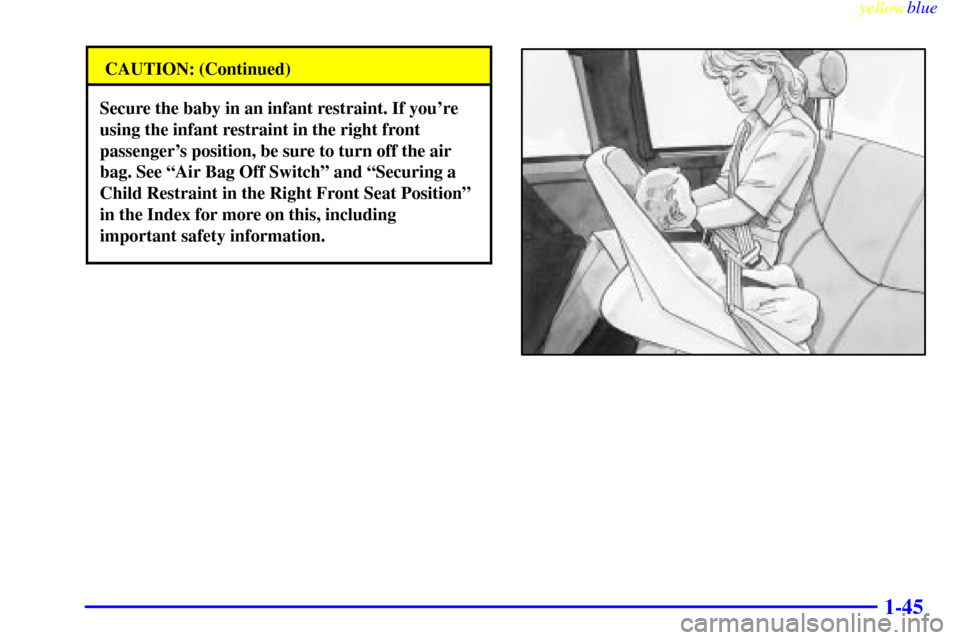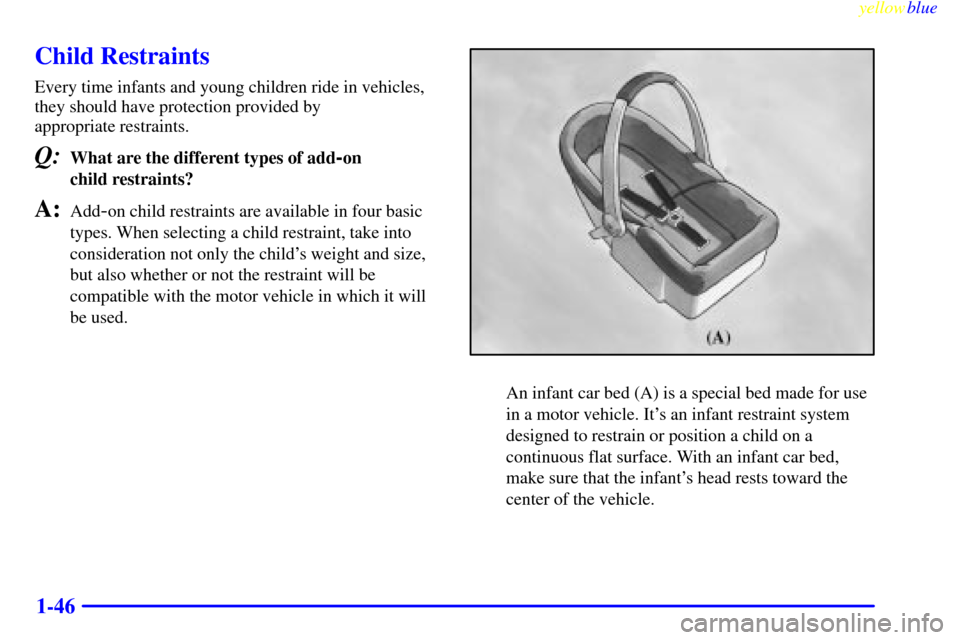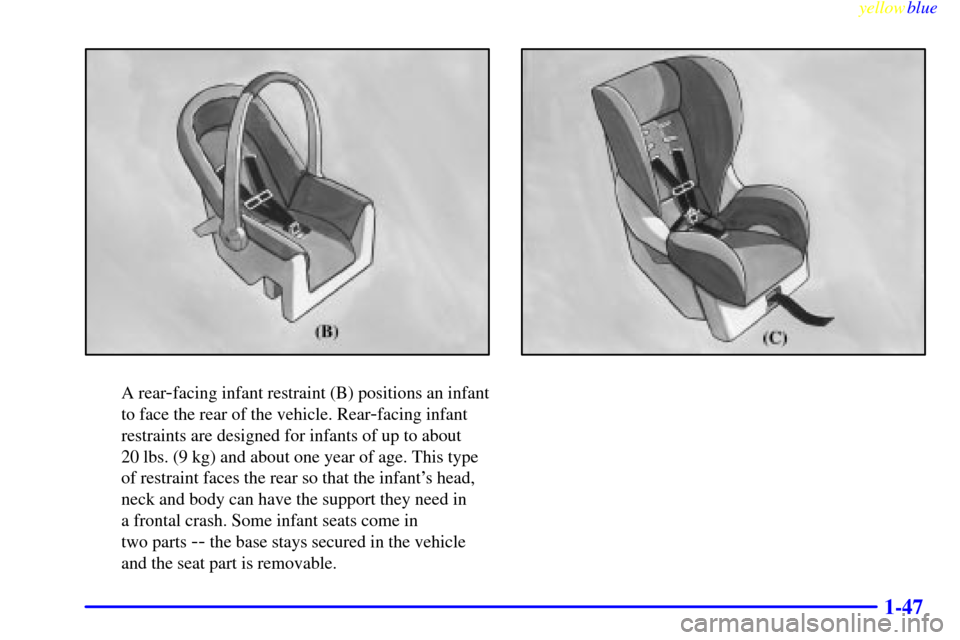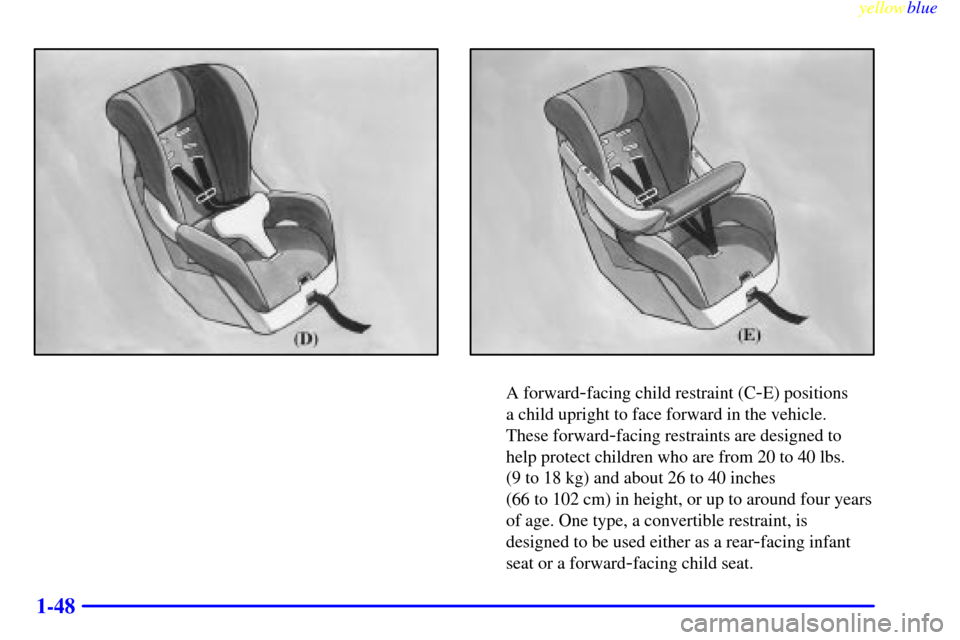CHEVROLET SILVERADO 2000 1.G Workshop Manual
SILVERADO 2000 1.G
CHEVROLET
CHEVROLET
https://www.carmanualsonline.info/img/24/8271/w960_8271-0.png
CHEVROLET SILVERADO 2000 1.G Workshop Manual
Trending: oil type, steering, fuel type, instrument panel, mirror controls, lock, oil level
Page 51 of 421
yellowblue
1-39
CAUTION:
You can be seriously hurt if your shoulder belt is
too loose. In a crash, you would move forward
too much, which could increase injury. The
shoulder belt should fit against your body.
To unlatch the belt, just push the button on the buckle.
Page 52 of 421
yellowblue
1-40
Rear Safety Belt Comfort Guides for
Children and Small Adults
If your vehicle has a rear seat, your vehicle has shoulder
belt comfort guides. This feature will provide added
safety belt comfort for children who have outgrown
child restraints and for small adults. When installed on a
shoulder belt, the comfort guide pulls the belt away
from the neck and head.
There is one guide for each outside passenger position in
the rear seat. To provide added safety belt comfort for
children who have outgrown child restraints and for
smaller adults, the comfort guides may be installed on
the shoulder belts. Here's how to install a comfort guide
and use the safety belt:
1. Remove the guide from its storage clip on the
interior body.
Page 53 of 421
yellowblue
1-41
2. Place the guide over the belt and insert the two edges
of the belt into the slots of the guide.3. Be sure that the belt is not twisted and it lies flat.
The guide must be on top of the belt.
Page 54 of 421
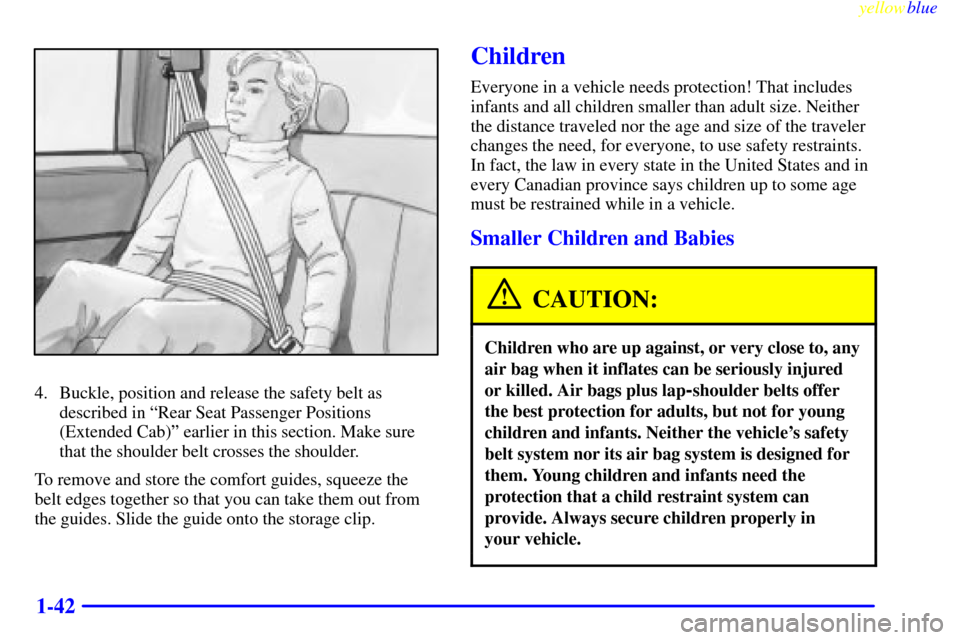
yellowblue
1-42
4. Buckle, position and release the safety belt as
described in ªRear Seat Passenger Positions
(Extended Cab)º earlier in this section. Make sure
that the shoulder belt crosses the shoulder.
To remove and store the comfort guides, squeeze the
belt edges together so that you can take them out from
the guides. Slide the guide onto the storage clip.
Children
Everyone in a vehicle needs protection! That includes
infants and all children smaller than adult size. Neither
the distance traveled nor the age and size of the traveler
changes the need, for everyone, to use safety restraints.
In fact, the law in every state in the United States and in
every Canadian province says children up to some age
must be restrained while in a vehicle.
Smaller Children and Babies
CAUTION:
Children who are up against, or very close to, any
air bag when it inflates can be seriously injured
or killed. Air bags plus lap
-shoulder belts offer
the best protection for adults, but not for young
children and infants. Neither the vehicle's safety
belt system nor its air bag system is designed for
them. Young children and infants need the
protection that a child restraint system can
provide. Always secure children properly in
your vehicle.
Page 55 of 421
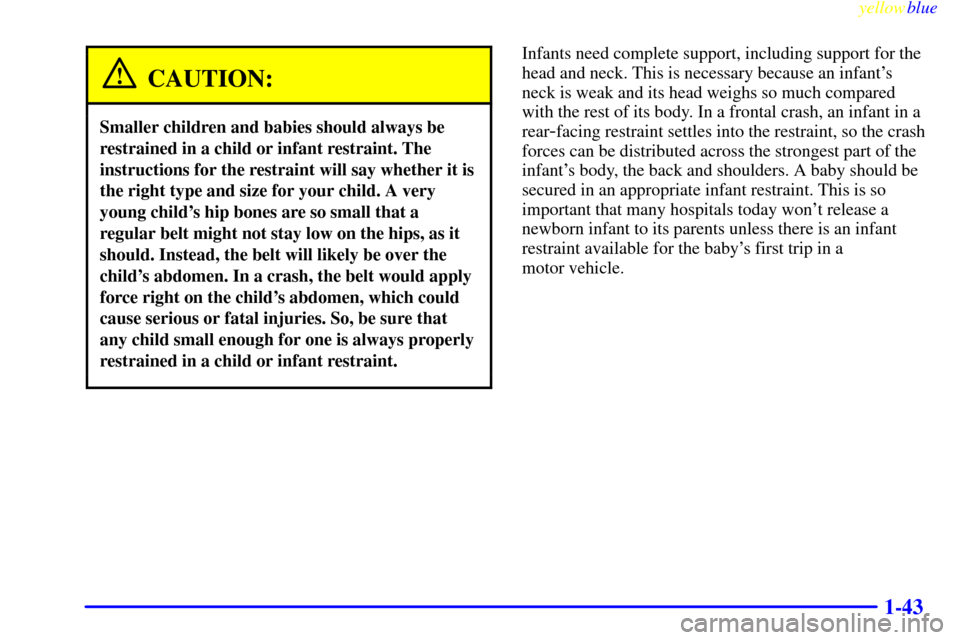
yellowblue
1-43
CAUTION:
Smaller children and babies should always be
restrained in a child or infant restraint. The
instructions for the restraint will say whether it is
the right type and size for your child. A very
young child's hip bones are so small that a
regular belt might not stay low on the hips, as it
should. Instead, the belt will likely be over the
child's abdomen. In a crash, the belt would apply
force right on the child's abdomen, which could
cause serious or fatal injuries. So, be sure that
any child small enough for one is always properly
restrained in a child or infant restraint.
Infants need complete support, including support for the
head and neck. This is necessary because an infant's
neck is weak and its head weighs so much compared
with the rest of its body. In a frontal crash, an infant in a
rear
-facing restraint settles into the restraint, so the crash
forces can be distributed across the strongest part of the
infant's body, the back and shoulders. A baby should be
secured in an appropriate infant restraint. This is so
important that many hospitals today won't release a
newborn infant to its parents unless there is an infant
restraint available for the baby's first trip in a
motor vehicle.
Page 56 of 421
yellowblue
1-44
CAUTION:
Never hold a baby in your arms while riding in a
vehicle. A baby doesn't weigh much
-- until a
crash. During a crash a baby will become so
heavy you can't hold it. For example, in a crash
at only 25 mph (40 km/h), a 12
-lb. (5.5 kg) baby
will suddenly become a 240
-lb. (110 kg) force on
your arms. The baby would be almost impossible
to hold.
CAUTION: (Continued)
Page 57 of 421
yellowblue
1-45
CAUTION: (Continued)
Secure the baby in an infant restraint. If you're
using the infant restraint in the right front
passenger's position, be sure to turn off the air
bag. See ªAir Bag Off Switchº and ªSecuring a
Child Restraint in the Right Front Seat Positionº
in the Index for more on this, including
important safety information.
Page 58 of 421
yellowblue
1-46
Child Restraints
Every time infants and young children ride in vehicles,
they should have protection provided by
appropriate restraints.
Q:What are the different types of add-on
child restraints?
A:Add-on child restraints are available in four basic
types. When selecting a child restraint, take into
consideration not only the child's weight and size,
but also whether or not the restraint will be
compatible with the motor vehicle in which it will
be used.
An infant car bed (A) is a special bed made for use
in a motor vehicle. It's an infant restraint system
designed to restrain or position a child on a
continuous flat surface. With an infant car bed,
make sure that the infant's head rests toward the
center of the vehicle.
Page 59 of 421
yellowblue
1-47
A rear-facing infant restraint (B) positions an infant
to face the rear of the vehicle. Rear
-facing infant
restraints are designed for infants of up to about
20 lbs. (9 kg) and about one year of age. This type
of restraint faces the rear so that the infant's head,
neck and body can have the support they need in
a frontal crash. Some infant seats come in
two parts
-- the base stays secured in the vehicle
and the seat part is removable.
Page 60 of 421
yellowblue
1-48
A forward-facing child restraint (C-E) positions
a child upright to face forward in the vehicle.
These forward
-facing restraints are designed to
help protect children who are from 20 to 40 lbs.
(9 to 18 kg) and about 26 to 40 inches
(66 to 102 cm) in height, or up to around four years
of age. One type, a convertible restraint, is
designed to be used either as a rear
-facing infant
seat or a forward
-facing child seat.
Trending: height, high beam, tire pressure, spark plugs replace, coolant level, fuel pump, towing capacity
